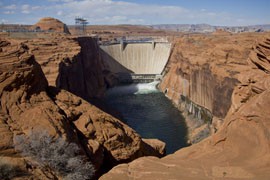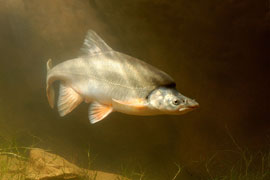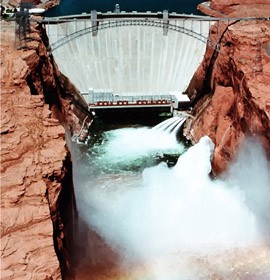Cronkite News has moved to a new home at cronkitenews.azpbs.org. Use this site to search archives from 2011 to May 2015. You can search the new site for current stories.
Court OKs government’s actions in Glen Canyon Dam operations
WASHINGTON – A federal appeals court ruled Monday that the government did not violate federal environmental law when it failed to subject annual plans for operation of the Glen Canyon Dam to a thorough environmental review.
The Grand Canyon Trust had argued that the Bureau of Reclamation needed to formally consult with the Fish and Wildlife Service over annual operation plans for the dam because of the potential impact on the endangered humpback chub population in the Colorado River.
But a three-judge panel of the 9th U.S. Circuit Court of Appeals upheld a lower-court ruling that said the dam’s regular operating plans were not major enough to warrant compliance with the Endangered Species Act and the National Environmental Policy Act.
A staff attorney with the trust called the court’s decision a minor setback. He said the environmental group plans to continue its five-year legal battle over the operation of the dam.
“It’s important that we put it in perspective, as we’ve won many rounds and now we’ve lost one round,” Neil Levine said. “We think anything this important is going to take a concerted effort and not a one-time win.”
Because of that threat of future litigation, the Bureau of Reclamation said it could not comment on Monday’s ruling. Other government agencies involved in the case could not be reached for comment or said they were still reviewing the court’s opinion and so were not able to comment Monday.
The case stems from the Bureau of Reclamation’s plan for water releases from the dam on the Arizona-Utah border. The dam creates Lake Powell, which provides drinking water to 25 million people and generates 3 million megawatt hours of electricity a year, the court said.
The bureau uses a modified low-fluctuating flow plan, in which water releases from the dam are driven by demand for the electricity generated there, which tends to be higher in summer and winter.
In a 1994 “biological opinion,” the Fish and Wildlife Service said that the modified low-fluctuating flow plan could harm the humpback chub downstream from the dam. But when the plan was proposed again in 2008, the service said it would not jeopardize the endangered fish.
The appeals court left the door open for the trust to continue challenging longer-term biological opinion and incidental take documents in the dispute.
But it rejected the trust’s argument that annual operation plans for the dam should be subject to Endangered Species Act challenges. That “would be unduly cumbersome and unproductive in addressing the substance of environmental issues,” the appellate judges wrote, adding that “there is no benefit to endangered species in having an unending judicial process concerning annual reporting requirements.”
Levine said the trust will pursue those longer-term documents, seeking policy change and grassroots support in addition to continued litigation.
“Those are the documents that destroy the habitat of the chub,” he said. “The chub and its critical habitat downstream has been destroyed over the last 15 years due to dam operations.”









